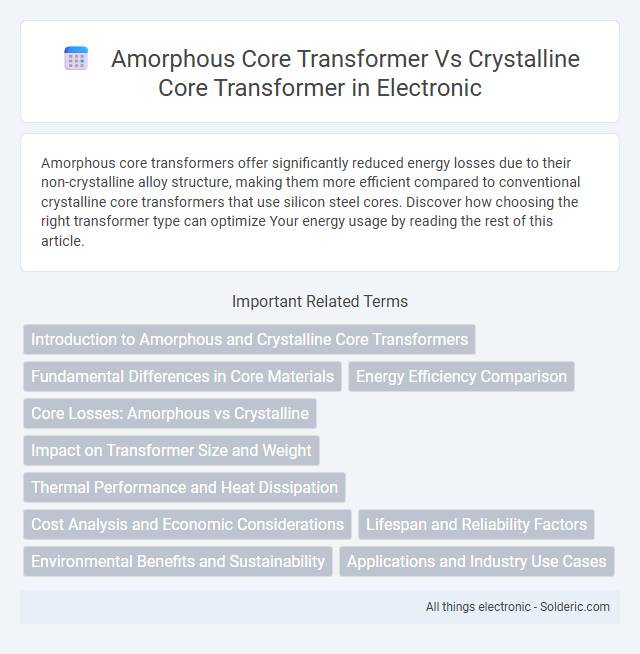Amorphous core transformers offer significantly reduced energy losses due to their non-crystalline alloy structure, making them more efficient compared to conventional crystalline core transformers that use silicon steel cores. Discover how choosing the right transformer type can optimize Your energy usage by reading the rest of this article.
Comparison Table
| Feature | Amorphous Core Transformer | Crystalline Core Transformer |
|---|---|---|
| Core Material | Amorphous metal alloy (non-crystalline) | Crystalline silicon steel |
| Energy Efficiency | High efficiency; lower core losses (0.3 - 0.5 W/kg) | Moderate efficiency; higher core losses (1.5 - 2.5 W/kg) |
| Magnetic Properties | Low hysteresis loss; high permeability | Higher hysteresis loss; moderate permeability |
| Noise Level | Lower audible noise | Higher audible noise |
| Weight | Lighter due to thinner laminations | Heavier with thicker laminations |
| Cost | Higher initial cost | Lower initial cost |
| Applications | Energy-saving distribution transformers, green energy projects | General purpose transformers, standard distribution networks |
| Temperature Stability | Better temperature stability | Moderate temperature stability |
Introduction to Amorphous and Crystalline Core Transformers
Amorphous core transformers utilize a non-crystalline, disordered metal alloy that significantly reduces core losses compared to traditional crystalline silicon steel cores. Crystalline core transformers, made from grain-oriented silicon steel, offer high magnetic permeability but experience higher hysteresis and eddy current losses. Understanding the differences in core material properties helps you select transformers optimized for energy efficiency and reduced operational costs.
Fundamental Differences in Core Materials
Amorphous core transformers utilize a non-crystalline, disordered atomic structure that significantly reduces core losses and enhances energy efficiency compared to crystalline core transformers, which are made from well-ordered, grain-oriented silicon steel. The unique atomic arrangement in amorphous cores minimizes hysteresis and eddy current losses, resulting in cooler operation and longer lifespan. Choosing amorphous core transformers for Your electrical systems can lead to lower energy consumption and reduced operational costs.
Energy Efficiency Comparison
Amorphous core transformers demonstrate significantly higher energy efficiency compared to crystalline core transformers due to their lower core losses, which can reduce no-load losses by up to 70%. The unique atomic structure of amorphous alloys minimizes hysteresis and eddy current losses, especially at low excitation levels typical in distribution systems. Consequently, this results in reduced operational costs and lower environmental impact over the transformer's lifespan.
Core Losses: Amorphous vs Crystalline
Amorphous core transformers exhibit significantly lower core losses compared to crystalline core transformers due to their non-crystalline metal structure, which reduces hysteresis and eddy current losses. The amorphous alloy's high electrical resistivity and irregular atomic arrangement minimize energy dissipation, enhancing efficiency, especially under partial load conditions. In contrast, crystalline cores suffer higher core losses because their ordered grain structure facilitates greater magnetic domain movement resistance and increased eddy currents.
Impact on Transformer Size and Weight
Amorphous core transformers significantly reduce size and weight compared to crystalline core transformers due to their higher magnetic permeability and lower core losses. The use of amorphous metal alloys in the core allows for thinner laminations and more efficient flux conduction, resulting in lighter and more compact designs. This size and weight reduction improves installation flexibility and lowers transportation and support structure costs.
Thermal Performance and Heat Dissipation
Amorphous core transformers exhibit superior thermal performance due to their lower core losses, resulting in reduced heat generation compared to crystalline core transformers. The unique atomic structure of amorphous metal allows for more efficient heat dissipation, maintaining cooler operating temperatures and enhancing transformer longevity. Choosing an amorphous core transformer can help optimize your system's thermal efficiency and reliability under continuous load conditions.
Cost Analysis and Economic Considerations
Amorphous core transformers generally have higher initial manufacturing costs due to the expensive raw materials and complex production processes involved. However, they offer significant energy savings and reduced operational costs over their lifespan, often leading to lower total cost of ownership compared to crystalline core transformers. Crystalline core transformers are cheaper upfront but incur higher energy losses, which increase long-term expenses and reduce economic efficiency.
Lifespan and Reliability Factors
Amorphous core transformers generally offer a longer lifespan and superior reliability due to their reduced core losses and lower operating temperatures, which minimize insulation degradation over time. Crystalline core transformers, while durable, tend to experience higher energy losses that contribute to increased thermal stress and faster wear on core materials. Choosing an amorphous core transformer can enhance your system's durability and reduce maintenance frequency, ensuring better long-term performance.
Environmental Benefits and Sustainability
Amorphous core transformers significantly reduce energy losses compared to crystalline core transformers, leading to lower greenhouse gas emissions and improved environmental sustainability. The use of amorphous metals in these cores results in cooler operation and extended transformer lifespan, minimizing resource consumption and waste generation. Choosing an amorphous core transformer can enhance your sustainability efforts by reducing carbon footprint and promoting energy-efficient infrastructure.
Applications and Industry Use Cases
Amorphous core transformers are predominantly used in energy distribution systems and renewable energy sectors due to their high efficiency and reduced core losses, making them ideal for improving grid performance and lowering operational costs. Crystalline core transformers find applications in industrial machinery and heavy electrical equipment where mechanical robustness and higher saturation flux density are critical. Your choice between these transformer types should align with specific industry demands such as energy savings in utility grids or durability in manufacturing environments.
amorphous core transformer vs crystalline core transformer Infographic

 solderic.com
solderic.com